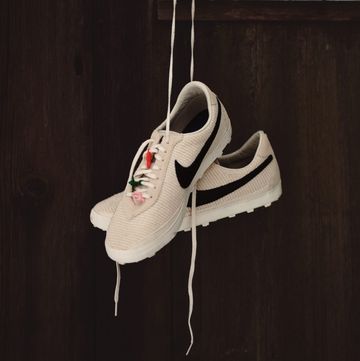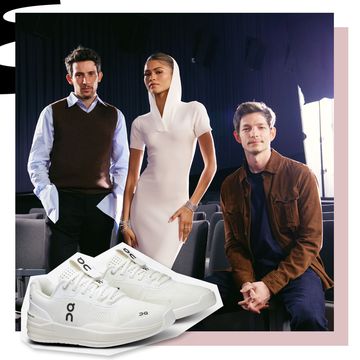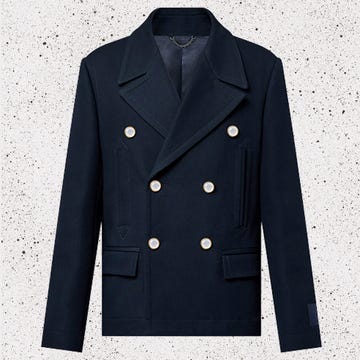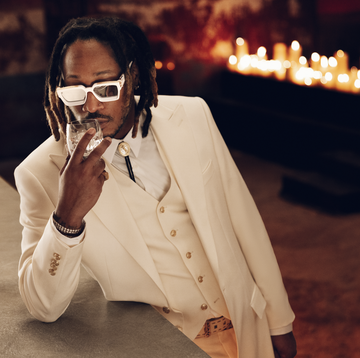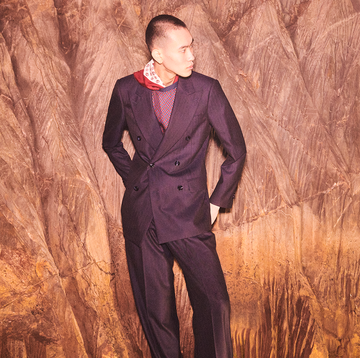When I first speak with Virgil Abloh in Paris, he is scheduled to fly back to Chicago in two days. Technically Chicago is home—it's where his wife Shannon and daughter Lowe live, and it's a two-hour drive from Rockford where he was born and raised—but he is rarely there. He takes roughly 350 flights a year. His phone is forever buzzing with texts and calls and emails. He is a man steeped in work to the point that even the notion of "home" is difficult for him to reconcile with the rest of his life.
"Home is home, but this is sort of my passion, my profession," Abloh tells me in Paris. "To me, it's not really work. It's the inherent process of, you know, doing the type of work I like doing, and that means a lot of meetings, travel, and phone calls."
Abloh is the designer behind Off-White, the independent fashion label headquartered in Milan and sold in high-end shops around the world, including its own retail stores in Hong Kong and Tokyo. His signature graphic—bold diagonal stripes—can be found on everything from phone cases to rugby shirts to collaborative Moncler parkas. He also deejays under the nom de guerre Flat White, and he advises Kanye West, by whom he was first hired in 2003. Perhaps most vitally though, Abloh is chief in the vanguard of a new kind of fashion populism.
No longer do newspapers and magazine critics have sole influence over what is sartorially desirable. Bloggers, models, musicians, actors, the generally and sometimes inexplicably famous—these are the new figures informing the landscape. Kylie Jenner and Gigi Hadid, both of whom wear Off-White, use their families' influence and their own social media machines to reify their celebrity, which they in turn use to mold fashion and trends. Google's metrics show that the ten most searched for fashion designers of last year include West, Beyoncé, Zendaya, Ivanka Trump, and Kendall and Kylie Jenner. Celebrity is influence, influence is power, and the digital realm provides an ever-expanding series of platforms from which to wield it.
Abloh understands this phenomenon of influence well and relies heavily on the ideas of trusted friends and advisors to provide him with intellectual material. His job, as he sees it, is to synthesize their disjointed ideas into cohesive wholes.
"I'm constantly inspired by my friends and the people I surround myself with and the cities that I'm traveling to," he says. "All the movements are made up by my brain trust. None of us sip the Kool-Aid. We're all individuals; we're all critics; we all look at things from a discerning eye, and I synthesize those things."
"I'm sort of a conduit," he continues, clarifying his own thoughts out loud as he often does. "I look at my friends, and I'm like, 'What could they get out of it?' And I sort of plug them in, and then I vicariously get what I need, which is inspiration, and, then, what they get out of it is a voice."
Abloh has mastered the influencer game: designer Stevie Dance, artist Cali Thornhill DeWitt, West, the Kardashians, the Hadids, and the Jenners, among many others, comprise an inner circle in which ideas and influence are exchanged. The strategy is simple: Pass around influence, burnish everyone's careers, and increase your own influential power and career while doing it.
When Abloh was first profiled in The New York Times, for instance, West told Matthew Schneier, "Virgil is one of the smartest, fastest, most innovative people I've created with." Abloh replied in turn, calling West "the greatest designer that has yet to be seen." In the new era of fashion populism, the critic is cut out of the equation. Who cares what Schneier thinks of Abloh or West's design? (Or what Cathy Horyn, Suzy Menkes, or Vanessa Friedman thinks for that matter?) For much of the fashion world, if the likes of West or Jenner or Abloh approves of you—and if you might be able to help them—little else matters.
Growing up middle-class in Rockford, Illinois, as the son of Ghanaian immigrants, Abloh had little idea what he wanted to do with his life. "I started off as a kid who didn't care what my education was," he says. "Later I was like, Oh, maybe I'm interested in niche culture. Street culture in the '90s, hip-hop—the music form—rock-and-roll. But I was gonna have a regular job, like a 9-to-5."
Abloh is reticent to discuss his childhood—which, culturally and socioeconomically, is a far cry from where he is now—but he is also unable to articulate where many of his own perspectives come from. Even seemingly basic bits of his background are elusive to him. "I don't know where my parents got my name," he says, as if the question of why two Ghanaians named their suburban-born son after a Roman poet had never come up. "I'm sure they saw it in a movie, maybe."
He subsequently studied engineering ("cool but not necessarily fulfilling") at the University of Wisconsin-Madison, where he also took a course on Renaissance art history before pursuing his master's degree in architecture at the Illinois Institute of Technology. After receiving his graduate degree, at age 22, he found work advising West. Now, he is the one being advised, and his synthesis of others' ideas has produced distinguished results. Anyone able to sell T-shirts for $300 has accomplished something, surely.
And yet, while he understands the modern necessity of having influential allies like West, Hadid, and the Jenners all sporting his wares and praising his name, he says he is not wholly contented to rely on them to shape his brand. Abloh wants to pull from his past as well.
"I'm interested in random kids from the urban city, middle America, black kids into skateboarding and graffiti, but who want to participate in fashion, in the art world," he says. "In previous generations, there weren't that many people from the same sort of position that I am, on any sort of scale. I'm trying to inspire a generation of kids who largely weren't taught to believe that you could do these sorts of things."
It is in this discussion that Abloh comes most alive. "There's a part of me that's trying to represent kids that don't necessarily have the same outlet that I have," he says. "I'm not looking towards a new demographic. I'm looking towards the demographic I came from."
Abloh wants to build something for those who came from backgrounds similar to him. The goal, he says, is to put the skateboard-and-graffiti urban style that comprised his childhood in a revered position—to make it mainstream—and in doing so make the demographic he came from more commercially acceptable.
"Fashion is in large part perception," he says. "Certain things are placed on certain pedestals just by committees, you know? My goal is to break down certain pedestals and put other things on them and see if they work."
And yet, the inherent paradox of fashion—of any kind of consumerist art—is a challenging one: While the inspiration in creation might come from the disenfranchised, only the fortunate can make it popular.
"Now's maybe the first time that people are dictating what they want from their brands," he says. "Fashion is more representative."
But if the people who decide what should be desired are already in influential positions, then it is their cohort that will inevitably be most represented. Abloh is right that he's at the forefront of something new, but it is not a socioeconomically flattened cultural landscape; it is the same stratified realm, just played out over different media.
Abloh is an exciting presence in the fashion world, but the divergence in his rhetoric—wanting to create for his demographic—from the contemporary reality—that one must create for Jenner and her influential kin to achieve popularity—has hindered his ability to make Off-White a truly memorable brand. The white stripes are easy enough to recognize, but what might be behind it is mixed and fragmented and without a core. For now, his style is purely aesthetic; without a central voice, it remains a disjointed hodgepodge of influencers' ideas.
Perhaps this is the point. Perhaps Abloh is striving for a Flaubertian aestheticism. ("No reflections," Flaubert wrote to a friend when writing Madame Bovary, "the author's personality is absent"). If this is the goal—clothes without a driving perspective or personality behind them—then he has no doubt succeeded. Indeed, he speaks often of "aesthetic sensibility." But if Abloh's aim is to target and inspire the demographic of his childhood, as he also says, then he has a ways to go.
His ability to synthesise the works of his influencers and friends is useful, but he's yet to have his own breakthrough, his own vision manifest. The irony is that he seems to know where that breakthrough might come from (his past), but in order to draw from it, he'll have to give up the race for influence and Instagram popularity in order to reflect—and eventually settle on a single point of view that may not satisfy every friend and influencer. To find a coherent sense of self, Abloh might have to leave behind the inner circle that made him successful in the first place.
It's difficult to tell if Abloh will ever be able to achieve this. At 36, he has ably transcended the shadow of West and has come into his own as a fashion talent. But his greatest contribution to fashion still lies mostly in soliciting the opinions and perspectives of trusted others. In a whirlwind ascent from middle-class suburbia to the top-tier of globetrotting fashion, his identity has only become more mixed-up. His conception of the past and of home has been superseded by busyness—by text messages and air miles and the modern reality of fashion's populism. Influence is everything. The demographic he comes from isn't going to create a killer Snapchat story seen by millions; they aren't going to show up on highly trafficked blogs or be regrammed by the inner circle.
If he actually wants to create for the kids of his past—especially as the head of a major fashion house, as he tells me he hopes to do—he'll have to decide what's more important: where he's going or where he comes from. Does he want to create with a strong, singular identity or a multifaceted one?
Two days after we spoke in Paris, he was in New York and headed to LaGuardia Airport to fly back to Chicago. We began discussing his place in the history of fashion, while he sat in the backseat of the car. "In fashion, there's a feeling that it's a renaissance [now]," he says. "There are certain innovations that, you know—the chiaroscuro approach to painting: That was an invention and an art form that progressed the whole genre. I always found that inspiring that that was, like, made up; it was an invention, in an art form."
When I ask him what his chiaroscuro is—what he thinks of as his historical contribution to the fashion world—he pauses for a while. "Screen printing words on fashion?" he finally offers.
The fact is, Abloh may not be entirely sure what his great contribution to fashion is. He speaks often of "representing what's on the street" and "putting it on the runway." He talks about his group texts and meet-ups where he sources ideas from his inner circle: sending WhatsApp messages, going to Café Select on Lafayette Street with his buddies and leveling sartorial criticism like, "'Yo, this is this,' or, 'Oh, this is too fashion.'"
Perhaps his chiaroscuro has yet to come. Abloh becomes truly excited about what he is doing is when he's talking about his past. "I'm looking towards the demographic I came from, and trying to inspire them," he tells me once more. It is difficult to tell whether he understands the apparent mutual exclusivity of being at the energetic center of the influencer culture and pulling back to create something truly meaningful and original. For this answer, we can do little but wait. But if he does find a coherent sense of self—of past, of home—he might go down in history like Caravaggio did: as a groundbreaking inventor.
Lead image of Abloh photographed by Eugene Shishkin.








